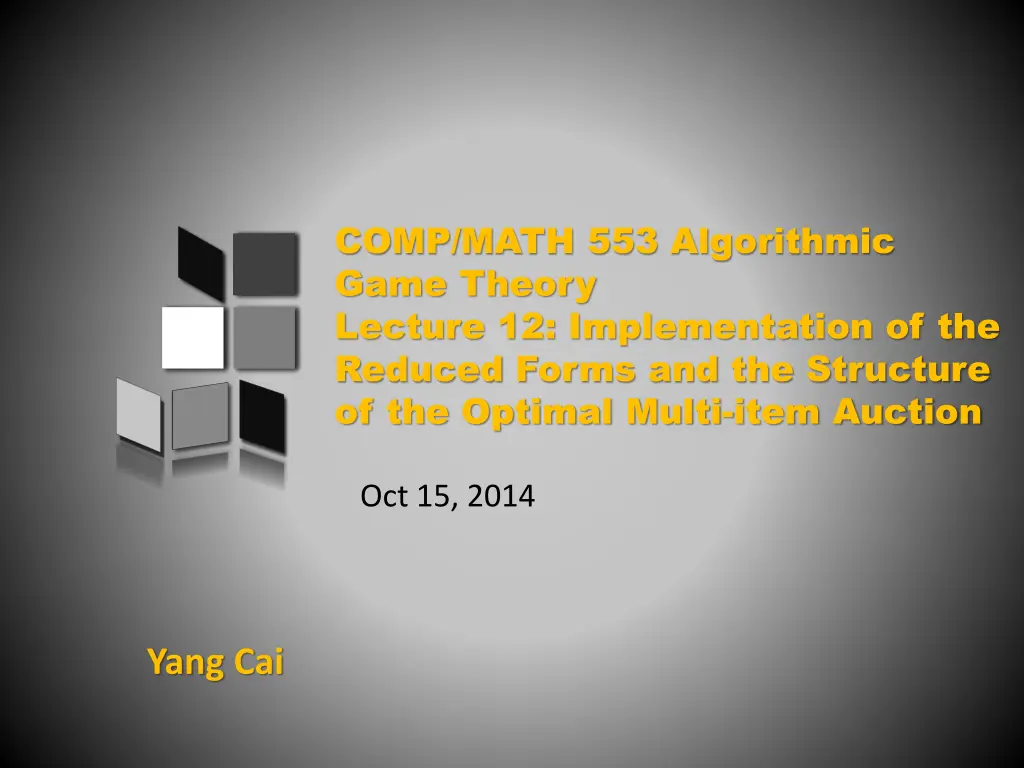
Implementation of Feasible Reduced Forms in Algorithmic Game Theory
Explore the intricacies of implementing feasible reduced forms in algorithmic game theory through LP variables, allocation rules, and auction structures. Understand the concept of convex polytopes and the optimization of revenue in auctions.
Download Presentation

Please find below an Image/Link to download the presentation.
The content on the website is provided AS IS for your information and personal use only. It may not be sold, licensed, or shared on other websites without obtaining consent from the author. If you encounter any issues during the download, it is possible that the publisher has removed the file from their server.
You are allowed to download the files provided on this website for personal or commercial use, subject to the condition that they are used lawfully. All files are the property of their respective owners.
The content on the website is provided AS IS for your information and personal use only. It may not be sold, licensed, or shared on other websites without obtaining consent from the author.
E N D
Presentation Transcript
COMP/MATH 553 Algorithmic Game Theory Lecture 12: Implementation of the Reduced Forms and the Structure of the Optimal Multi-item Auction Oct 15, 2014 Yang Cai
New Decision Variables Variables: Interim Allocation rule aka. REDUCED FORM : * : Pr( valuation vi ) j i i ij(vi) :E[ pricei * ] i valuation vi
A succinct LP Variables: ij(vi): probability that item j is allocated to bidder i if her reported valuation (bid) is vi in expectation over every other bidders valuations (bids); pi(vi) : price bidder ipays if her reported valuation (bid) is vi in expectation over every other bidder s valuations (bids) Constraints: BIC: for all vi and v i in Ti IR: for all vi in Ti Feasibility: exists an auction with this reduced form. Objective: Expected revenue:
Implementation of a Feasible Reduced Form After solving the succinct LP, we find the optimal reduced form * and p*. Can you turn * and p* into an auction whose reduced form is exactly * and p*? This is crucial, otherwise being able to solve the LP is meaningless. Will show you a way to implement any feasible reduced form, and it reveals important structure of the revenue-optimal auction!
Implementation of a Feasible Reduced Form
Set of Feasible Reduced Forms Reduced form is collection ; Can view it as a vector ; Let s call set of feasible reduced forms ; Claim 1:F(D) is a convex polytope. Proof: Easy! A feasible reduced form is implemented by a feasible allocation rule M. M is a distribution over deterministic feasible allocation rules, of which there is a finite number. So: , where is deterministic. Easy to see: convex hull of reduced forms of feasible deterministic mechanisms So, F(D) =
Set of Feasible Reduced Forms F(D) ? Q: Is there a simple allocation rule implementing the corners?
* Is there a simple allocation rule implementing a corner? F(D) virtual welfare maximizing interim rule when virtual value functions are the fi s ------ (1) expected virtual welfare of an allocation rule with interim rule --- (2) interpretation: virtual value derived by bidder i when given item j when his type is A
Is there a simple allocation rule implementing a corner? F(D) virtual welfare maximizing interim rule when virtual value functions are the fi s ? Q: Can you name an algorithm doing this? A: YES, the VCG allocation rule ( w/ virtual value functions fi, i=1,..,m ) = : virtual-VCG( { fi } ) interpretation: virtual value derived by bidder i when given item j when his type is A
Characterization Theorem [C.-Daskalakis-Weinberg] F(D) is a Convex Polytope whose corners are implementable by virtual VCG allocation rules. F(D) How about implementing any point inside F(D)?
Carathodorys theorem If some point x is in the convex hull of P then Carath odory sTheorem: If a point x of Rd lies in the convex hull of a set P, there is a subset P of P consisting of d + 1 or fewer points such that x lies in the convex hull of P . For example: x = (0,1) + (1,0) + (0,0)
Characterization Theorem [C.-Daskalakis-Weinberg] Any point inside F(D) is a convex combination (distribution) over the corners. F(D) The interim allocation rule of any feasible mechanism can be implemented as a distribution over virtual VCG allocation rules.
Structure of the Optimal Auction
Characterization of Optimal Multi-Item Auctions Theorem [C.-Daskalaks-Weinberg]: Optimal multi-item auction has the following structure: 1. Bidders submit valuations (t1, ,tm) to auctioneer. 2. Auctioneer samples virtual transformations f1, , fm 3. Auctioneer computes virtual types t i = fi(ti) 4. Virtual welfare maximizing allocation is chosen. Namely, each item is given to bidder with highest virtual value for that item (if positive) 5. Prices are charged to ensure truthfulness.
Characterization of Optimal Multi-Item Auctions Theorem [C.-Daskalaks-Weinberg]: Optimal multi-item auction has the following structure: 1. Bidders submit valuations (t1, ,tm) to auctioneer. 2. Auctioneer samples virtual transformations f1, , fm 3. Auctioneer computes virtual types t i = fi(ti) 4. Virtual welfare maximizing allocation is chosen. Namely, each item is given to bidder with highest virtual value for that item (if positive) 5. Prices are charged to ensure truthfulness. Exact same structure as Myerson! - in Myerson s theorem: virtual function = deterministic - here, randomized (and they must be)
Interesting Open Problems Another difference: in Myerson s theorem: virtual function is given explicitly, in our result, the transformation is computed by an LP. Is there any structure of our transformation? In single-dimensional settings, the optimal auction is DSIC. In multi- dimensional settings, this is unlikely to be true. What is the gap between the optimal BIC solution and the optimal DSIC solution?
